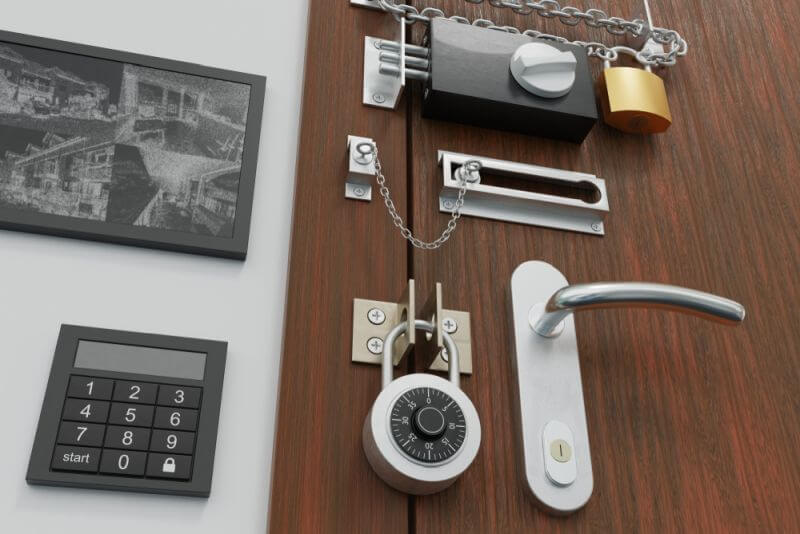Most people today don’t live in places where they can set aside an entire room for emergency needs. On the other side of the equation, good quality tools, electronic devices, and advanced survival products can be expensive.
A portable panic room cart will bring you one step closer to making every room in your home a place where you can shelter in time of need. Advantages include:
- The supplies on the cart are always ready for use.
- You can stage it in any room. When combined with other resources in the room, it will be ready to use as the panic room.
- Save room in a small apartment or cottage by dividing your supplies up.
- Avoid having large caches in one area that can be stolen or damaged.
- Avoid duplicating expensive items or ones you don’t use often.
- If you have to move to another room during an emergency, you can pick up items from other rooms and load them onto the cart.
Let’s say you need 15 gallons of water to survive two weeks. That amount of water takes up a lot of space that you may not have in every room of your home. Now let’s also say you have 4 rooms on the ground floor of your home that can be used as a panic room.
Instead of putting all 15 gallons in 1 room, put 8 in each room instead, and then 7 on the cart. In a time of need, all you need to do is move the cart to have 15 gallons of water in any room that you think will work best for an emergency. You will also have extra water in the other rooms in case you need them.
Method and Strategy for Refocusing Each Room for Survival Needs
In a time of need, you never know which room will be best. For example, in a tornado, you will want to be in an inner room, downstairs, or in a cellar. During a hurricane, you will want an upper-level room or attic. When you put a panic cart on each floor, you can easily utilize all these rooms and be ready for any emergency.
Making each room ready to be a panic room requires some planning. Here are the basic points to consider and mark on a map of your home and each room:
- Which closets or other areas will you use to store survival-related items such as water and non-perishable food?
- How will you set up fields of fire and other defensive needs?
- Where will your sleeping, cooking, and toiletry areas be?
- Where will you place heating, cooling, and air quality devices?
- If you have to pitch a tent to conserve heat, where will you put it?
- How will you manage pets and children, and make the area safe for them?
Once you know where everything will be, the next step is to make each room ready to accommodate changes in spatial arrangements. For example, if you have heavy tables and chairs, now is the time to install furniture movers on the legs or feet.
Choosing a Panic Cart
This cart can be as simple as a child’s toy wagon with a large cargo box in the interior. You can also use a folding metal shopping cart with rear wheels and two front standing bars. Another option is four-wheeled carts that come in various sizes. Some have shelves and can hold up to 150 pounds. If you go with a four-wheeled cart, make sure it has locking casters.
Heavy-duty stainless steel food service carts with casters are ideal. These carts are about three feet long by three feet tall with three adjustable shelves. This cart can easily hold 150 lbs. or more. It is designed to be stored just about anywhere and is very easy to move.
When choosing a cart, make sure you can move it from its position to any location you desire within 5 to 10 minutes. Practice with the cart so you know what corners you have to turn or other challenges you may encounter.
Choosing Items to Store on the Cart
- Food and Water for yourself, children, and pets
You can choose any percentage of what you would need for 2 weeks to store on the cart. If you have a very limited budget or little space in each room, this may be as high as 80%. - Tools
Keep a small screwdriver kit that also has drive sockets and bits for various kinds of fasteners. You should also have a good pair of regular pliers, needle nose pliers, an adjustable wrench, a tape measure, a small saw, duct tape, and a hammer. It will also help to have a small electronics repair kit so that you can access the battery compartment or fix minor issues if they come up. - Communications and Electronics
The mobile panic cart is the perfect place to store flashlights, batteries (preferably rechargeable), a spare phone/tablet, a battery power bank, solar/crank-powered radio. You can also include a dedicated solar recharging unit if your crank radio doesn’t have a USB port for charging other devices. Store these devices in a fire/water-resistant EMP-safe envelope or wallet along with any USB drives or other data storage devices that you can use in conjunction with the phone or tablet.
You can also store manual communications devices on the cart such as flares, mirrors, whistles, or anything else that might signal to nearby people that you are in the home and need help if the phones aren’t working. If you know how to use a ham radio and can afford one, this would also be a good item for the cart. - Hygiene Items for yourself, children, and pets
These items include a comb, toothpaste, toothbrushes, hand wipes, paper towels, toilet paper, and a portable potty kit including urine solidifier powder. You should also have two buckets so that you can store filled bags in one while you use the other. For pets, you can use disposable potty mats that have chemicals in them similar to the ones in the portable potty kit. - Heating and Cooking Devices
If you are in a closed room without any ventilation, don’t use a charcoal grill, candle heaters, or anything else that uses an open flame. Carbon monoxide is a silent killer. - Sleeping and Comfort
If you are using a lower percentage of food and water on the cart, then you can use that space for a battery-powered electric blanket. Just make sure that you have enough battery banks and a charging device that can keep it going.
To save space, at a minimum store the silver emergency blankets and an inflatable air mattress.
Look for an air mattress that has a battery-powered unit for inflation so that you don’t have to concern yourself with an additional pump and powering it. A small tent will also be useful if you need to conserve heat during cold weather or other times when you have little fuel or other resources to stay warm. - Medications and First Aid Supplies
These supplies include rubbing alcohol, hydrogen peroxide, scissors, pain medication, bandages, and anti-allergy shots if you need them. This is also the perfect place to store extra OTC and prescription medications. This is also a good place to store chemical heating and cooling packs. Keep extra chemical cooling packs stashed in each room as you would water and food. You can use them with a battery powered fan for emergency cooling within a tent. - Self Defense Weapons
This is a personal matter based on your skills with various weapons. You may want to keep everything from pepper spray and knives to a gun and ammo. If you are going to put a gun on the cart, also include at least 200 rounds of ammo and a cleaning kit.
When stored on the cart, make sure weapons are not readily accessible to others. Keep them in a locked box. For a gun, make sure the ammo is out and locked in another box. Once you are in an emergency, you will have full control of the gun at all times, so it makes sense to load then.
Remember, this is not your EDC gun, nor is it one you would go for during a house invasion. This weapon is strictly for a situation where you need to have a weapon in a room you will be using during an emergency.
Maintaining the Cart
As with any other stored supplies for an emergency, you may never use them. That doesn’t mean items won’t expire or become unusable. Keep a list of everything on the cart, and replace items as they come up to their expiration date. In addition, fire up battery-powered devices monthly to make sure they are in good working condition.
If you have all of your survival supplies on stationary shelves, or in one location, it can cost your life when you realize you need to use a different room or you can’t get to the supplies. When combined with decentralized supply caches, a mobile panic cart can help you save money, reduce space needed for survival supplies, and expand your panic room options in a time of need.








































































So many things that just don’t seem right to me. I will have to think about what this post is really saying. But I do know if you have to get to a “Panic Room” you won’t have time to stop in a room to add stuff to your “Cart”.
A champion shooter? I was a competitive shooter for 20 plus years, know hundreds of shooters from all over the country, but I’ve never heard of Fred in the shooting sports. I have shot in all the National matches, pistol, rifle, shotgun, 3 gun, trap skeet bullseye, even tried cowboy action and I have never heard Fred. USPSA mostly. I have heard of Fred in the prepping world but not in competitive shooting sports. I retired from competitive shooting 3 years ago. NO, I never won a match. I did it to shoot under pressure, not to go against corp. sponsored shooters that have $8000.00 guns. I shot factory made non altered weapons. The weapons I would use in a SHTF situation. Yes, it was costly with travel and lodging shooting fees and ammo, but it was a great learning tool for learning to shoot under pressure.